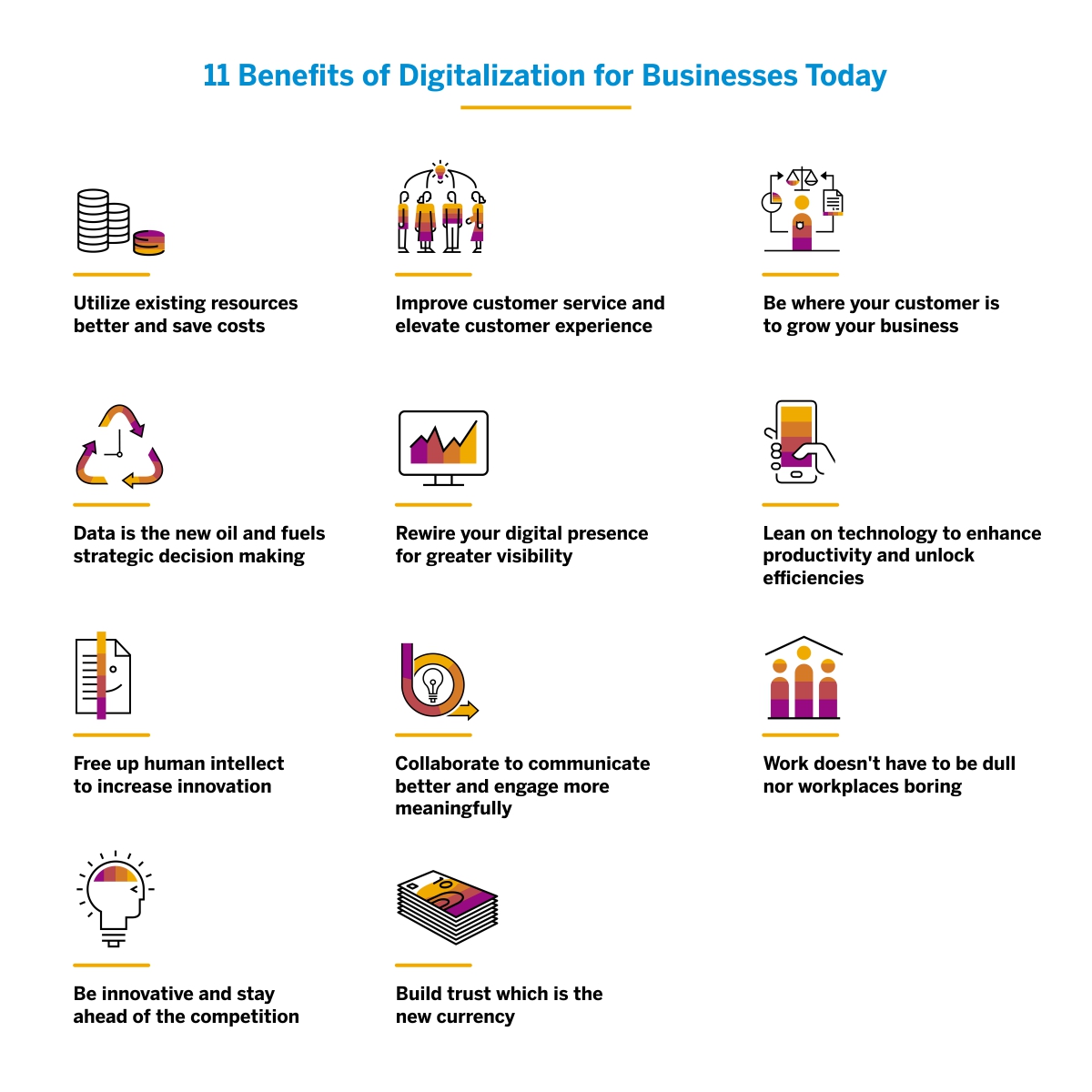With the significant changes the world has undergone in the last decade, more so after the COVID-19 pandemic, the term ‘digitalization’ has become more pervasive. It has redefined how businesses operate in every sphere, from recruitment to go-to-market strategies to customer acquisition and retention.
In a world that’s constantly changing, digitalization has been that much-needed anchor that has helped businesses build resilience amidst disruption. It’s helped businesses harness data to garner better customer insights and competitor tracking in real time basis. Given how digital-savvy today’s customers are, it’s become critical for companies to embark on digital transformation journey, if nothing to keep up with the customer and ensure consistent customer experience across omni-channels and platforms.
But why this emphasis on digitalization? When did digitalization become the lifeline of companies looking to survive in changing business environments, looking to stay agile and responsive?
The digitalization story
Digitalization is more than the integration of technology into different facets of business. True digitalization completely changes the way an organization functions including its processes, systems, and culture. In an era where everything, from the way we work to the way we shop, has been recalibrated digitalization has been at the center of this change. Collaborative tools, data moving to the cloud, online commerce, connected devices, Artificial intelligence and machine learning, Industry 4.0, Workplace 4.0 – each of these are an intrinsic and important part of the digitalization story.
With millennials and Gen Z being an always-on consumer group, it has become critical for companies to have a digitalization strategy, which keeps pace with changing market dynamics.
Having the right digitalization strategy will help companies in reducing costs while optimizing efficient use of resources (both technology and people). A digitalization strategy also helps to measure the size and scale of a business, the targeted customers and the digital supply chain involving both.
The key driver for embarking on digitalization is usually costs related. Other factors are starting to take center stage, from enabling employees to work from anywhere and having access to data anywhere (which is where the cloud becomes a driver) to ensuring great customer experiences and superlative customer service (connected customers are the driver). Digitalization brings process improvements across all aspects of an enterprise: business functions (like human resources, marketing, and operation), the entire business ecosystem (including stakeholders and vendors), asset management (including customers and their data), work culture and digital supply chain between employees and customers.
Benefits of digitalization
Digitalization isn’t about short-term gains but about achieving a company’s long-term strategy, which goes beyond expanding its business presence or standing out from the competition. The pitfalls of ignoring digitalization are evident. In times of disruption such as the pandemic, digitalization enabled businesses to stay connected to customers and continue to offer their services uninterrupted; small businesses, especially, that had digitally transformed survived and thrived pivoting on technology.
Here are the top benefits of digitalization that you shouldn’t ignore:
-
Saving costs is topmost for businesses
The first and immediate benefit of digitalization is cost optimization (of resources) and cost savings. Companies are using their digital transformation initiatives to bring in efficiencies and utilize existing resources better, a direct cost implication. Automation saves time and eradicates duplication and repetitiveness of tasks, again a cost reduction. By monitoring processes constantly, there’s a reduced possibility of (manual) error. This also leads to predictive response, instead of reactive which in turn leads to greater agility.
-
Customer is the king and customer service is queen
The old ‘customer is king’ has never been more apt than now. With customers adapting to digital everything (from accessing brands to building relationships with brands online) companies need to be quicker to cater to this digitally savvy customer. A unified view of the customer offered by CRM software can help keep track of this complex customer journey and offer personalized service. Linking CRM and ERP will help companies provide great customer service that will translate to great customer experience. Digitalization enables constant and consistent improvement of products/service leading to elevated customer experience while efficiencies in inventory management results in optimized costs.
-
Be where your customer is to grow your business
Today’s customer doesn’t have a linear journey to a brand. They browse online, check instore and purchase online. By having digital presence on all possible channels and platforms companies can constantly stay connected with customers, communicate with them, address concerns and prevent escalations- a death knell in this age of always-on consumers. Due to digitalization, companies can stay connected through mobile applications, social media content and forms, emails and other platforms, something unknown earlier. By offering services where the customer is present, a company can build deeper relationship and customer loyalty.
-
Data is the new oil and will fuel strategic decision making
Never has it been easier to harness data and derive insights that transform how businesses run and plan for the future. Digitalization has helped companies to make sense of data – organized data that enables predictive instead of reactive decisions. It’s not cliched that ‘data is the new oil,’ but the truth. Without data, companies cannot take strategic decisions from understanding what are new market opportunities to figuring out if customers are ready for a new product or assessing whether employees and satisfied and motivated to work. Data fuels strategic business decisions across all aspects of the organization (marketing, sales, customer service, product development, human resources, etc.). Due to data availability in organized, customized, and personalized data structures, digitalization has made decision-making faster and easier.
-
Rewire your presence in the digital world to create greater visibility
Heightened competition and ever-changing consumer behavior can only be addressed through digitalization. Tracking competition real-time and tracking consumer sentiment real-time will enable companies to stay competitive and customer-centric. To do both, companies need to be present on every available digital platform offering their services (websites, online stores, etc.) and communicate through all available online media (blogs, social networking handles, websites, etc.) ensuring brand reach and visibility. Since today’s digital-first natives are just that digital, companies’ shifting or pivoting business to digital platforms has also put e-commerce on hyper thrust mode.
-
Lean on technology to enhance productivity and bring in efficiencies
One of the primary benefits of digitalization is increasing productivity and efficiencies, whether it be man or machines. For instance, digitalization allows you to free up time of employees, who can then focus on innovation and driving business growth, while automating mundane, repetitive tasks. Industrial Internet of Things (IIoT), for instance, monitors machinery in real-time assessing performance and breakages and through AI/ML it enables predictive maintenance instead of reactive, increasing efficiency within the system.
-
Free up human intellect to increase innovation
When automation allows humans to focus their time and efforts on making process improvements or product innovation, digitalization transforms how businesses work. Instead of looking at short term gains, digitalization leads businesses to look at sustainable growth, generating efficiencies and improving products and services. Besides accelerating improvement across all levels, it also opens ways to streamline the digital supply chain of resources and data.
-
Collaborate to communicate better and engage more meaningfully
The recent trend of remote working clearly highlights one of the top benefits of digitalization. Companies that had transformed digitally were able to provide employees with anytime, anywhere secure access to data while collaborative tools helped them work from anywhere. As companies move towards a hybrid working model, digitalization will create a level playing field for ‘back to office’ workers and those that continue to work remote.
-
Work doesn’t have to be dull nor workplaces boring
Another key benefit and an area that will show immediate results of digitalization is the workplace and the work environment. Using digital tools to constantly gauge employee sentiment and revisit HR policies has instant results: better adjusted employees, happier employees. Digitalization isn’t about technology alone, but the culture. A digital culture that accompanies digital transformation is sure to increase employee productivity and engagement levels. From flexible working hours to increased employment options with new teams to a renewed focus on teleworking, digitalization has helped human resource function in organization to keep their ears to the ground and act, rather than react. It also helps talent management to retain talent and decrease attrition.
-
Stay ahead of the competition
Digital is where the new battle ground is, and companies must get used to this new reality. To stay in the game, companies need to aggressively track what the competition is doing including product launches, GTM and perceived new market opportunities. Digitalization allows companies to do all this, from tracking new feature enhancements to existing products to design changes to websites and social/digital marketing strategies. Having such information allows the companies to be more competitive, and be innovative catching in new trends and advancements introduced by their direct and indirect rivals. A company’s digitalization strategy needs to encompass competition audit, monitoring and assessment to win the game.
-
Trust is the new currency
Whether it’s employees or customers, trust brought about by transparency is the deal maker or breaker. The 2021 Edelman Trust Barometer revealed an epidemic of misinformation and widespread mistrust of societal institutions and leaders around the world. This left businesses with a clear mandate to rebuild trust to chart a new course. Digitalization enables companies to have transparency in all their transactions, a must-have in a 24/7, always on, always connected world (both customers and employees). Whatever the online platform, digitalization provides companies with the wherewithal to keep their key stakeholders informed of any changes before it happens – building trust. It allows companies to be honest, authentic, and transparent in their responses – cementing trust.

What next in your digitalization story
Every small- and large-scale enterprise has a digital transformation agenda. Digitalization is no longer a nice to have, it’s a must have. Companies that have already embarked on their digitalization journey are looking at new ways to pivot on technology learning from their past mistakes and experiences. Consumer behavior has drastically changed in the past two years and this evolution will only continue. Consumers will continue to adapt digital means to initiate relationships, and if companies are to stay competitive, they need to be ahead of the curve. Digitalization is a mega trend, one that will play an even more important role in the years to come.
No realm of business will be untouched by digitalization and no aspect of human life either. From drug development to cancer treatment, from AI-driven manufacturing to deep collaboration in Workplace 4.0, companies need to prepare for the next wave of digitalization. There will be a greater focus on technologies such as AI/ML and Blockchain which would allow companies to get an ‘inside’ look of what drives consumer sentiments and how to leverage these insights. AI will let companies to leverage data, find the right set of customers and focus more on this ‘ideal’ customer profile offering unparalleled customer experience and increasing revenue through new leads that close because of ‘data insights.’
There will be further innovations and developments in the current set of technologies, perhaps new applications, and these are sure to shape the path to success. Companies will need to constantly recalibrate their digitalization strategy to take advantage of new developments, ensure that these developments lead to increased productivity and efficiencies. They will need to relook their strategies and frameworks to incorporate any requisite changes without disrupting the normal course of business.
For a more convenient flow of work and data within the company, the development of a more intuitive visual interface should also be on the radar to bring about effectiveness and increased automation. The cost-effectiveness of a digital transformation process will be a critical factor in the years ahead as businesses begin to emerge out of the pandemic and related disruptions. There will be structural shifts on an ongoing basis and well into the future, especially in the digital supply chain, hence return on technology will become a key factor.



